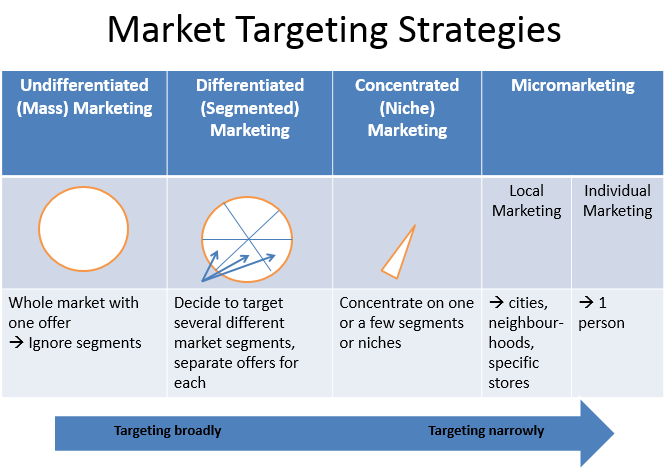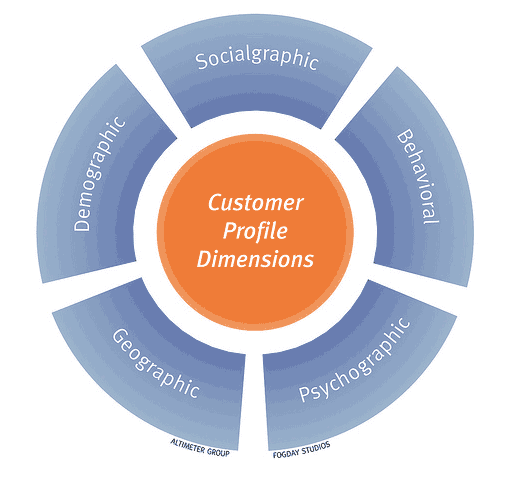Blogging
what is target marketing | Target Marketing Strategies beginners Guide 2024

In today’s competitive business landscape, it is crucial for companies to effectively reach their intended audiences. This is where target marketing strategies come into play. Target marketing involves identifying and understanding the specific needs, preferences, and behaviors of a particular customer segment and tailoring marketing efforts accordingly. By doing so, businesses not only maximize their chances of success but also optimize their marketing resources. In this article, I will provide insights into the importance of target marketing and share practical tips on how to develop effective strategies to engage and convert your target audience.
What is Target Marketing

Target marketing refers to the practice of identifying and focusing on a specific segment of the market that is most likely to be interested in the products or services offered by a business. It involves tailoring marketing efforts to reach the needs and preferences of a specific group of consumers, rather than trying to target the entire market. By understanding the characteristics and behaviors of the target market, businesses can create more effective marketing strategies that generate higher returns on investment.
Definition of Target Marketing
Target marketing is a strategy that involves identifying a specific segment or segments of the market that are most likely to be interested in a particular product or service. This segment is often referred to as the target market. By focusing marketing efforts on this target market, businesses can maximize their resources and ensure that their messages are delivered to the right audience.
Importance of Target Marketing
Target marketing is crucial for businesses for several reasons. First and foremost, it enables companies to save time, money, and other resources by ascertaining and directing their marketing efforts toward the individuals and groups most likely to become customers. This laser-like focus ensures that marketing messages are not wasted on those who are not interested or likely to purchase the product or service. Additionally, target marketing allows businesses to differentiate themselves from competitors by offering tailored solutions that meet the specific needs and preferences of their target market. This differentiation can lead to increased customer loyalty and a higher likelihood of repeat purchases.
Benefits of Target Marketing
There are numerous benefits associated with implementing target marketing strategies. By identifying the target market, businesses can create more relevant and personalized marketing campaigns, resulting in higher response rates and conversion rates. This allows businesses to maximize their marketing budget as they are not spending valuable resources trying to reach individuals who are not interested in their offerings. Target marketing also enables businesses to better understand their customers’ needs, which can lead to product enhancements or the development of new products tailored specifically to the target market. Ultimately, employing target marketing strategies can lead to increased customer satisfaction, brand loyalty, and overall business growth.
Target Market Identification
Before implementing any marketing strategy, it is crucial to identify the target market accurately. This involves segmenting the market based on certain criteria and understanding the demographics and psychographics of the target audience.
Segmentation
Market segmentation is the process of dividing a broader market into smaller, more manageable segments. These segments are created based on common characteristics, needs, or behaviors shared by individuals within the segment. By dividing the market into segments, businesses can tailor their marketing efforts to address the unique needs and preferences of each segment. Market segments can be based on various factors such as age, gender, income level, lifestyle, geographic location, and more.
Demographics
Demographic factors such as age, gender, income, education, and occupation play a significant role in target market identification. Understanding the demographics of the target market helps businesses in crafting marketing messages that resonate with the intended audience. For example, marketing a luxury skincare product to college students might not be as effective as marketing the same product to affluent middle-aged individuals who are more likely to have the disposable income and the desire for such products.
Psychographics
Psychographics refers to the study of individuals’ attitudes, interests, opinions, and lifestyle choices. It goes beyond basic demographic information and delves into individuals’ personalities, values, and motivations. Psychographic segmentation allows businesses to understand their target market on a deeper level and create marketing campaigns that are emotionally resonant and captivating. By understanding the psychographics of the target market, businesses can develop messaging and branding strategies that align with their audience’s values and aspirations.
Market Research
Before implementing any target marketing strategies, it is essential to conduct thorough market research. This research helps businesses gather and analyze information about the target market, competitive landscape, and industry trends.
Primary Research
Primary research involves collecting data firsthand by conducting surveys, interviews, focus groups, or observational studies. This type of research allows businesses to obtain specific and up-to-date information directly from their target market. It can provide valuable insights into consumer preferences, buying behavior, and market trends. Primary research can be time-consuming and expensive, but it provides businesses with unique and tailored data that can be highly beneficial in developing effective marketing strategies.
Secondary Research
Secondary research involves gathering data from existing sources such as market reports, industry publications, government databases, and academic research. This type of research is cost-effective and provides businesses with a broader understanding of the market landscape. Secondary research can help identify industry trends, competitor strategies, and target market characteristics. While secondary research may not provide as detailed or specific information as primary research, it is a valuable starting point for businesses to gain insights into their target market and industry.
Market Analysis
Market analysis involves examining the gathered data to understand the current market conditions and identify opportunities and challenges. It helps businesses understand the competitive landscape, assess the demand for their products or services, and identify any gaps in the market that they can leverage. Market analysis provides businesses with a comprehensive understanding of their target market and allows them to develop marketing strategies that are aligned with market needs and trends.
Understanding Consumer Behavior
To effectively target a market, businesses must understand the factors that influence buying decisions and consumer behavior. By studying consumer behavior, businesses can create marketing strategies that resonate with their target audience and motivate them to make a purchase.
Factors Influencing Buying Decisions
Several factors influence consumer buying decisions. These include personal factors such as individual preferences, needs, and lifestyle choices, as well as external factors such as cultural, social, and economic influences. Understanding these factors allows businesses to tailor their marketing messages and strategies to address the specific needs and motivations of their target market. For example, a luxury fashion brand targeting affluent consumers may emphasize exclusivity and status in their marketing campaigns, while a budget-friendly clothing brand may focus on affordability and value for money.
Consumer Needs Analysis
Conducting a thorough analysis of consumer needs is essential to develop products or services that cater to the target market’s demands. By understanding the needs and desires of their target audience, businesses can craft marketing messages and product offerings that effectively meet these needs. This analysis can be conducted through surveys, interviews, or market research studies. By aligning their offerings with consumer needs, businesses can enhance customer satisfaction and loyalty, leading to increased sales and business growth.
Market Trends
Staying up to date with market trends allows businesses to anticipate changes in consumer preferences and adapt their marketing strategies accordingly. By analyzing market trends, businesses can identify emerging needs or shifts in consumer behavior and tailor their offerings and messaging to tap into these evolving trends. This allows businesses to stay ahead of the competition and remain relevant in a rapidly changing market.:max_bytes(150000):strip_icc()/Term-Definitions_Target-market-49a03b58f6d54ddd88d46521f248fc8a.jpg)
This image is property of www.investopedia.com.
Developing a Target Marketing Strategy
Once the target market has been identified and consumer behavior has been understood, businesses can develop a comprehensive target marketing strategy that aligns with their goals and objectives.
Setting Marketing Goals
Before implementing any marketing strategies, it is crucial to establish clear and measurable goals. Marketing goals can be focused on increasing brand awareness, driving sales, expanding market share, or launching new products. These goals provide a roadmap for businesses and ensure that marketing strategies are aligned with broader business objectives.
Identifying Target Market Needs
Understanding the needs and preferences of the target market is crucial to developing a successful marketing strategy. By conducting market research and audience analysis, businesses can identify the pain points, desires, and motivations of their target audience. This information helps businesses tailor their products, messaging, and marketing channels to effectively meet the needs of their target market.
Positioning and Differentiation
Positioning refers to the perception of a brand or product in the minds of consumers. Differentiating a brand from competitors is essential to successful target marketing. By identifying unique selling propositions and competitive advantages, businesses can position themselves as the preferred choice within their target market. This can be achieved through branding, marketing messages, product features, or exceptional customer service. Effective positioning and differentiation help businesses stand out in a crowded marketplace and attract the attention of their target audience.
Marketing Mix Elements in Target Marketing
The marketing mix, also known as the Four Ps (Product, Price, Place, Promotion), plays a significant role in target marketing. These elements must be carefully considered and strategically implemented to support a successful target marketing strategy.
Product Strategy
Product strategy involves developing products or services that cater to the specific needs and preferences of the target market. By understanding consumer needs and conducting market research, businesses can create products that stand out from competitors and address the pain points of their target audience. Additionally, product strategy includes decisions related to branding, packaging, features, and quality control.
Pricing Strategy
Pricing strategy involves determining the optimal price for a product or service that will appeal to the target market while ensuring profitability for the business. Pricing decisions should consider factors such as the perceived value of the product, competitor pricing, production costs, and target market affordability. By analyzing market research and understanding consumer behavior, businesses can develop pricing strategies that maximize revenue and meet the needs of their target market.
Distribution Strategy
Distribution strategy involves determining the most effective channels through which to deliver products or services to the target market. This includes decisions related to brick-and-mortar versus online sales, direct sales versus distribution partners, and geographic reach. By understanding the preferences and behaviors of the target market, businesses can ensure that their products are available through the most convenient and accessible channels.
Promotion Strategy
Promotion strategy involves determining the most effective marketing channels and tactics to reach the target market. This includes advertising, public relations, sales promotions, and other promotional activities. By utilizing market research and consumer behavior insights, businesses can develop promotional strategies that effectively communicate the value proposition of their product or service to the target market.
This image is property of welpmagazine.com.
Digital Marketing Strategies
In today’s digital age, businesses must incorporate digital marketing strategies into their target marketing efforts to effectively reach and engage their target audience.
Online Advertising
Online advertising allows businesses to reach their target market through various digital platforms such as search engines, social media networks, and websites. By utilizing targeting tools and analytics, businesses can tailor their online advertisements to specific demographics, interests, and behaviors. Online advertising provides businesses with the ability to reach a larger audience and track the effectiveness of their campaigns through metrics such as click-through rates, impressions, and conversions.
Social Media Marketing
Social media marketing involves utilizing social media platforms such as Facebook, Instagram, Twitter, and LinkedIn to engage with the target market. By creating content that aligns with the interests and preferences of their target audience, businesses can build brand awareness, foster customer relationships, and drive sales. Social media marketing also offers the opportunity for businesses to gather valuable insights about their target market through social listening and analytics.
Search Engine Optimization
Search Engine Optimization (SEO) refers to the practice of optimizing a website to rank higher in search engine results pages. By implementing SEO strategies, businesses can increase their visibility and organic traffic from search engines. This allows them to reach individuals actively searching for products or services related to their target market. SEO involves various techniques, including keyword research, on-page optimization, content creation, and link building.
Measuring Target Marketing Success
To determine the effectiveness of target marketing strategies, businesses must establish key performance indicators (KPIs) and regularly analyze analytics and metrics.
Key Performance Indicators
Key performance indicators help businesses track and measure the success of their target marketing strategies. KPIs can include metrics such as sales revenue, customer acquisition rate, conversion rate, customer lifetime value, and brand visibility. By monitoring these KPIs, businesses can evaluate the impact of their marketing efforts on overall business performance and make data-driven decisions.
Analytics and Metrics
Analyzing analytics and metrics allows businesses to gain insights into their target market’s behavior, preferences, and engagement levels. Tools such as Google Analytics provide data on website traffic, user behavior, and conversions. Social media analytics provide information about reach, engagement, and audience demographics. By analyzing these metrics, businesses can track the success of their marketing campaigns, identify areas for improvement, and refine their target marketing strategies.
This image is property of cdn.educba.com.
Adapting Target Marketing Strategies
Target marketing strategies must be adaptable to respond to changing market conditions, consumer behavior shifts, and competitor actions.
Market Segmentation Changes
As market conditions evolve, it is essential to reassess and potentially adjust target market segmentation strategies. New market segments may emerge, or existing segments may change in size, preferences, or behaviors. By staying vigilant and regularly evaluating target market dynamics, businesses can ensure that their marketing efforts remain relevant and effective.
Consumer Behavior Shifts
Consumer behavior is not static, and it can change due to various factors such as economic conditions, technological advancements, or social trends. Businesses must monitor and understand these consumer behavior shifts to adapt their target marketing strategies accordingly. This may involve revising messaging, updating product offerings, or changing promotional tactics to align with the new consumer preferences and motivations.
Competitor Analysis
Monitoring competitors’ actions and strategies is essential to stay competitive within the target market. By conducting regular competitor analysis, businesses can identify potential threats, recognize opportunities, and adjust their target marketing strategies accordingly. This may involve differentiating product offerings, adjusting pricing strategies to remain competitive, or developing innovative marketing campaigns to outshine competitors.
Case Studies on Target Marketing
Examining successful target marketing campaigns and learning from failed marketing campaigns can provide valuable insights into the dos and don’ts of target marketing.
Successful Target Marketing Campaigns
One successful target marketing campaign is Apple’s “Get a Mac” campaign. Through this campaign, Apple targeted a specific market segment – users dissatisfied with PCs and interested in an alternative computing experience. The campaign featured a series of TV commercials showcasing the contrast between a Mac and a PC, highlighting the Mac’s simplicity, reliability, and design. This campaign effectively positioned Apple as the preferred choice for individuals seeking a user-friendly and stylish computer, successfully capturing a significant market share.
Lessons Learned from Failed Marketing Campaigns
One example of a failed marketing campaign based on poor target marketing is Pepsi’s commercial featuring Kendall Jenner. The ad received widespread criticism for trivializing social justice movements and failed to resonate with the target audience. The commercial lacked an authentic connection to the social issues it aimed to address, resulting in public backlash and a damaged brand image. This case demonstrates the importance of thoroughly understanding the target market’s values, needs, and preferences, as well as the potential consequences of failing to do so.
In conclusion, target marketing is a critical strategy for businesses seeking to maximize the impact of their marketing efforts. By identifying and focusing on a specific segment of the market, businesses can tailor their strategies to meet the unique needs and preferences of their target audience. Through effective market research, understanding consumer behavior, developing targeted marketing strategies, and continually adapting to market changes, businesses can create successful target marketing campaigns that drive growth and success.
Also Read… what is content marketing | Content Marketing Strategies for successful Blogging in 2024
Also Read… What is SEO, How Search engine optimization can help your Business.
Also Read… what is target marketing | Target Marketing Strategies beginners Guide 2024







